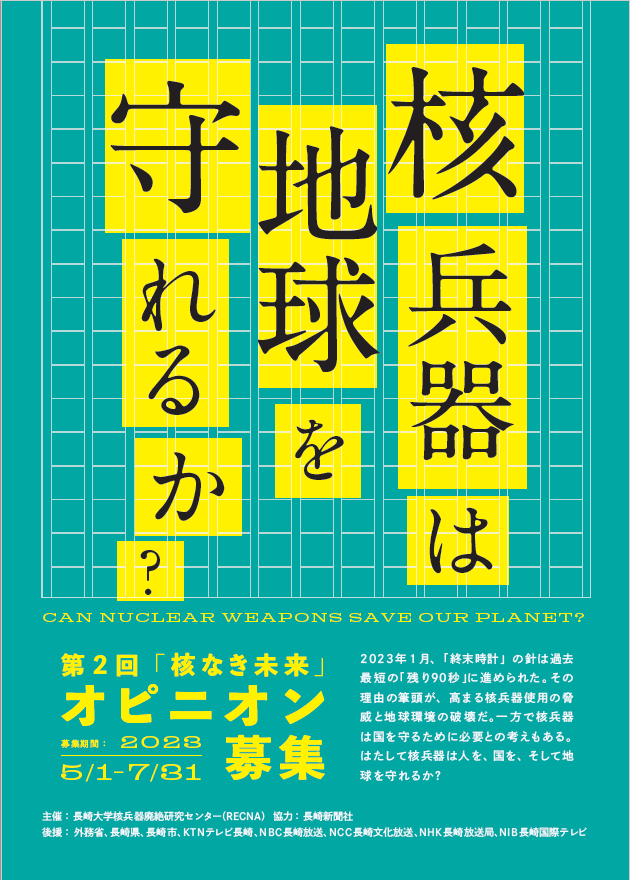RECNA Newsletter Vol.12 No.1 (September 30, 2023)
RECNA / UCS Workshop on Nuclear Disarmament
“Developments in US nuclear weapons policy and the implications for Northeast Asia”
The video is now available on YouTube!
Date: October 16 (Mon) 9:00 am – 11:00 am (JST)
Place: Room A-12, 1st floor, Main Building, Faculty of Environmental Science,
Bunkyo Campus, Nagasaki University (Online delivery available)
Access: https://www.nagasaki-u.ac.jp/en/access/bunkyo/index.html
Bunkyo Campus Map (PDF)
◆ Outline of the Workshop (PDF) ◆
We are now facing unprecedented nuclear crises. It is a critical time to analyze the policies of the nuclear weapon states and assess the implications of new trends. We are fortunate scientists and analysts from the Global Security Program of the Union of Concerned Scientists (UCS) will visit Nagasaki University. The Research Center for Nuclear Weapons Abolition at Nagasaki University (RECNA) and UCS are co-organizing a special workshop on nuclear issues with the cooperation of the NURESCA project and Nuclear Abolition and Arms Reduction Research Group at Nagasaki University. The workshop will be open to the public and available on-line. We hope it will be useful for those looking of a better understanding of US nuclear policies and their implications for Northeast Asia.
| Cooperation: | NURESCA Project / Nagasaki University Nuclear Abolition and Arms Reduction Research Group |
| Language: | English only |
| Registration: | Registration is closed. |
| Contact: | (E-mail) recna_staff@ml.nagasaki-u.ac.jp |
Agenda
| Moderator: Prof. Keiko Nakamura (RECNA) | |
| 9:00-9:05 | Welcome by Prof. Fumihiko Yoshida (Director, RECNA) |
| 9:05-9:20 | Overview of US Missile Defense and Implications Dr. Laura Grego, Senior Scientist and Research Director (UCS) |
| 9:20-9:35 | Problems with US Plans for Plutonium Pit Production Dr. Dylan Spaulding, Senior Scientist (UCS) |
| 9:35-9:50 | North Korean Plutonium Production Capacity Dr. Sulgiye Park, Senior Scientist, (UCS) |
| 9:50-10:05 | Potential for US-China Nuclear Conflict Mr. Robert Rust, China Analyst (UCS) |
| 10:05-10:20 | Analysis of the U.S. Nuclear and Military Budget Ms. Eryn MacDonald |
| 10:20-10:25 | Break |
| 10:25-10:55 | Free Discussion: (Moderator: Prof. Tatsu Suzuki (RECNA)) |
| 10:55-11:00 | Closing Remark by Dr. Gregory Kulacki (UCS and RECNA) |
List of Participants

|
Laura Grego |
| Laura Grego is a senior scientist and the research director of the Global Security Program at the Union of Concerned Scientists, where she has worked at the intersection of science and public policy, in particular nuclear weapons, missile defense, and space security issues, for twenty years. She recently completed a Stanton Nuclear Security Fellowship at the Laboratory for Nuclear Security and Policy at MIT. Before joining UCS, Dr. Grego was a postdoctoral researcher at the Harvard-Smithsonian Center for Astrophysics. | |

|
Dylan Spaulding Presentation Material(PDF) The Status of US National Laboratories |
| Dylan Spaulding is a senior scientist in the Global Security Program at the Union of Concerned Scientists. His work focuses on technical issues related to nuclear weapons and policies that can reduce the threat they pose. Dr. Spaulding earned his undergraduate degree in physics from Brown University and Ph.D in Earth and Planetary Sciences from UC Berkeley. Dr. Spaulding has long been involved with the US national labs as an intern, NNSA Stockpile Stewardship Graduate Fellow, and visiting scientist and experimenter. He was a postdoctoral researcher at the Commissariat à l’Energie Atomique in France and Origins Initiative fellow at Harvard University. Most recently, he commissioned and directed the Shock Compression Laboratory at UC Davis, where he also taught undergraduate geology. | |

|
Sulgiye Park Presentation Material(PDF) Status on North Korea’s Fissile Material Production |
| Sulgiye Park is a Senior Scientist in the Global Security Program at the Union of Concerned Scientists. Her work focuses on the front and back end of the nuclear fuel cycle, monitoring and verifying nuclear activities, and analyzing fissile nuclear materials stockpiles. Before joining UCS, Dr. Park worked as a research scientist at the Stanford Doerr School of Sustainability, where she looked at rare-earth metal supply chain issues in the US. She was also a MacArthur and Stanton Nuclear Security Fellow at Stanford University’s Center for International Security and Cooperation (CISAC), where her research focused on: analyzing geological resources, including uranium and critical metal resources, in North Korea; and radioactive waste management. She published multiple papers on North Korea’s uranium mining and milling processes for disarmament and nonproliferation efforts. Dr. Park holds a Ph.D. in n Geological Sciences from Stanford University, where her thesis work involved characterization of nuclear and earth materials under extreme conditions. | |
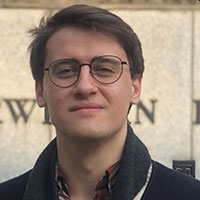
|
Robert Rust Presentation Material(PDF) China’s Nuclear Buildup and Potential for Conflict |
| Robert Rust is a China Analyst with the Global Security Program at the Union of Concerned Scientists. He focuses on China’s nuclear weapons program, Chinese governance, and the US-China relationship. Before joining UCS, Mr. Rust spent six months as a Graduate Trainee at the Norwegian Embassy in Beijing in 2019. While writing his master’s thesis, he was a Graduate Research Fellow at the Norwegian Institute of International Affairs in Oslo. Mr. Rust holds a bachelor of arts in International Relations/Chinese from the College of William and Mary, and a master of arts in Chinese Culture and Society from the University of Oslo in Norway. | |

|
Eryn MacDonald Presentation Material(PDF) The US Nuclear Weapons Budget: The Sky’s the Limit? |
| Eryn MacDonald, an analyst with the Global Security Program since December 2011, is an expert in international security, arms control and nonproliferation, U.S.-China relations, and East Asian security. She has a master’s degree in government from Cornell University, where she wrote a master’s thesis on Chinese space weapons policy. Between her graduate work at Cornell and graduating from Dartmouth with a bachelor’s degree in government, Ms. MacDonald spent four years as a program assistant with the UCS Global Security Program. Just before returning to UCS, she coordinated internships for the International Science and Technology Initiative at the Massachusetts Institute of Technology. | |

|
Gregory Kulacki |
| Gregory Kulacki is a Senior Analyst and the China Project Manager for the Global Security Program of the Union of Concerned Scientists (UCS). He is also a Visiting Fellow at the Research Center for Nuclear Weapons Abolition (RECNA) at Nagasaki University. He works on improving cross-cultural communication between the United States of America, China and Japan on nuclear weapons and related security issues. Prior to joining UCS in 2002, Dr. Kulacki was the Director of External Studies at Pitzer College, an Associate Professor of Government at Green Mountain College and the China Director for the Council on International Educational Exchange. Gregory completed his doctorate in government and politics at the University of Maryland College Park. | |

|
Fumihiko Yoshida |
| Prof. Fumihiko Yoshida is the Director of the Research Center for Nuclear Weapons Abolition (RECNA) at Nagasaki University. He was a Deputy Director of the Editorial Board of the Asahi Shimbun. He served as a member of the Advisory Panel of Experts on Nuclear Disarmament and Non-Proliferation for Japan’s Minister of Foreign Affairs. He is Editor-in-Chief of Journal for Peace and Nuclear Disarmament (J-PAND). He has a PhD in International Public Policy from Osaka University (2007). | |

|
Tatsujiro Suzuki |
| Prof. Tatsujiro Susuki is the Vice Director of the Research Center for Nuclear Weapons Abolition (RECNA) at Nagasaki University He was born in 1951. Before joining RECNA, he was a Vice Chairman of Japan Atomic Energy Commission (JAEC) of the Cabinet office (2010-2014). He is also a Council Member of Pugwash Conferences on Science and World Affairs (2007-09 and from 2014~). Dr. Suzuki has a PhD in nuclear engineering from Tokyo University (1988). | |

|
Keiko Nakamura |
| Prof. Keiko Nakamura is an Associate Professor in the Research Center for Nuclear Weapons Abolition (RECNA) at Nagasaki University. She is the Former Secretary-General of “Peace Depot” and has a Master’s Degree in International Policy Studies from Middlebury Institute of International Studies at Monterey. | |
“A Guide to the World’s Nuclear Warheads Count June 2023” was released. Please click on the thumbnail images below and download the pdf guide and poster.
Guide to World’s Nuclear Warheads Count

|
English Guide to the Worldʼs |

|
|
How to make leaflets:
Print the English Guide (PDF) for making leaflets on both sides of A3 paper, and fold it in two then in three.
|
>> Previous editions can be downloaded from here.
2nd Essay Contest Award Ceremony Held [JPN]
The Research Center for Nuclear Weapons Abolition, Nagasaki University (RECNA) has selected Grand Prize and Second Prize Award winners in the U-20 (16-20 years old) and U-30 (20-30 years old) categories for the second annual “Opinions on a Nuclear Weapons Free Future” and held an award ceremony as follows.
The two Grand Prize “opinions” were published in full in the September 24, 2023 issue of the Nagasaki Shimbun. (A Japanese article in the electronic edition of the same newspaper)
【 2nd “Opinion” Contest Award Ceremony 】
 |
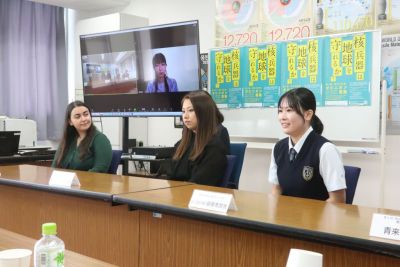 |
|
| Group photo of award ceremony attendees | Four award winners being interviewed |
| DATE/TIME: |
Saturday, September 23, 2023 Award Ceremony: 13:00-14:00 Press Interviews: 14:00-14:30 |
|---|---|
| VENUE: |
1st floor, Research Center for Nuclear Weapons Abolition, Nagasaki University |
| PROGRAM: |
1. Opening Remarks by Prof. Tatsujiro Suzuki, Deputy Director of RECNA 2. Announcement of Winners and Award Ceremony
U-20 Division
U-30 Division 3. Comment on the awarded essays 4. Comments by the other members of the Selection Committee 5. Group Photography |
| PRESS Interviews: |
Speakers: Mr. Seirai, Award winners Moderator: Prof. Suzuki Interpreter: Associate Prof. Keiko Nakamura |
Winners of the 2nd Essay Contest Announced [JPN]
The Research Center for Nuclear Weapons Abolition, Nagasaki University (RECNA) held a call for “opinions” applying to the 2nd Essay Contest on “Nuclear Weapons and Our Future”, with the aim of raising awareness of the importance of nuclear weapons issues among the younger generation and fostering human resources who can contribute to the realization of a peaceful international society.
We are pleased to announce that we have selected one Grand Prize winner and one Second Prize winner in each of the U-20 (16 to 20 years old) and U-30 (20 to 30 years old) divisions.
[⇒ 2nd Essay Contest Award Ceremony]
【 Winners: 2 Grand Prize Winners, 2 Second Prize Winners 】
* Age at time of application.
U-20: Grand Prize |
Minako Baba(17 years old)
Sophomore at Seiwa Jogakuin High School. Lives in Sasebo City, Nagasaki Prefecture. |
|
|---|---|---|
U-30: Grand Prize |
Adiya Kerimbayeva(27 years old)
Nagasaki University Graduate School of Biomedical Sciences, Disaster and Radiation Medicine, 2nd year of Master course. Lives in Nagasaki City, Nagasaki Prefecture. |
|
U-20: Second Prize |
Haruka Unno(19 years old)
Sophomore, School of Cultural Planning, Waseda University. Lives in Minato-ku, Tokyo. |
|
U-30: Second Prize |
Adriana Nazarko(25 years old)
Bowdoin College, International Relations and Asian Studies, Class of 2021. Lives in St. Petersburg, Florida, U.S.A. Lives in Minoh City, Osaka, Japan. |
【 U-20: 20 Finalists excluding winners / 88 Total Applicants 】
【 U-30: 18 Finalists excluding winners / 38 Total Applicants 】
Vol.6, Issue 1 of Journal for Peace and Nuclear Disarmament (J-PAND) is now available online. There are 15 open access articles. In the issue, we focus on the future of strategic stability by seeking to clarify profound challenges to the concept while also offering novel scholarly as well as policy-relevant approaches to better understanding and mitigating the risks of instability.
A Guide to the World’s Fissile Material Inventory June 2023
“A Guide to the World’s Fissile Material Inventory June 2023” has been released! Please click on the thumbnail images below and download the pdf guide and poster.

|
Guide to the World’s |
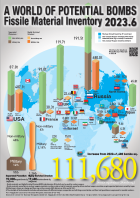
|
|
How to make leaflets:
Print the English Guide (PDF) for making leaflets on both sides of A3 paper, and fold it in two then in three.
|
>> Previous editions can be downloaded from here.
“World’s Fissile Material Data” 2023 [All Lists]
The 2023 World’s Fissile Material Data have been published. Please click on the following thumbnail images and download the pdf posters.
| Japanese | English | Korean | |
| Jun. 2023 | 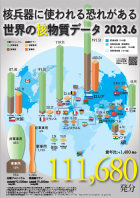 |
 |
 |
The special feature of this year’s map is that the total fissile material inventory, which decreased last year, has once again increased due to an increase in the amount of separated plutonium. The total inventory of HEU was 1,260 tons, equivalent to 19,680 warheads (an increase of 6 tons or about 80 warheads from last year), but this is due to a difference in the way the figures for “Other Non-nuclear Weapon Countries” are treated, and is not a substantial increase. However, the overall rising trend in separated plutonium continues, with an increase in plutonium for civilian use (mainly in France), bringing the total inventory to 552 tons, equivalent to 92,000 warheads (an increase of 8 tons or about 1,400 warheads from last year). As a result, the total inventory amount increased to equivalent to 111,680 warheads, an increase of around 1,480 warheads from last year (110,200 warheads).
◆ “A Guide to the World’s Fissile Material Inventory June 2023” Released!
Please access here.
◆ The two images to the right can be enlarged by clicking on them. You can also view and download the following PDF versions.
 ・The 2023 Global Inventory Map of Fissile Material (PDF)
・The 2023 Global Inventory Map of Fissile Material (PDF)
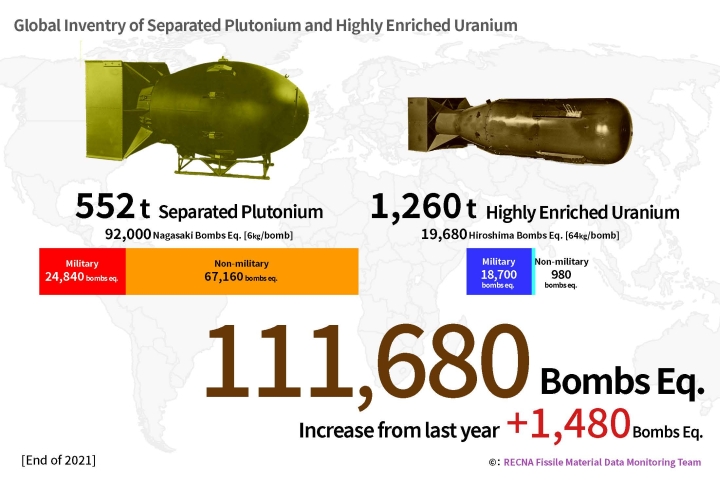 ・The 2023 Global Inventory of Fissile Material (PDF)
・The 2023 Global Inventory of Fissile Material (PDF)
◆ You can see the original data of the map from the following links.
・Global Inventory of Separated Plutonium
・Global Inventory of Highly Enriched Uranium
◆ You can see previous “World’s Fissile Material Data” from [All Lists].
◆ The 2023 World’s Nuclear Warheads Data have been published too.

“World’s Nuclear Warheads Data” 2023 [All Lists]
The 2023 World’s Nuclear Warheads Data have been published. Please click on the following thumbnail images and download the pdf posters.
| Japanese | English | Korean | |
| Jun. 2023 |  |
 |
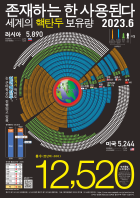 |
◇ “A Guide to the World’s Nuclear Warheads Count June 2023” Released!
Please access here.
◇ You can see previous “World’s Nuclear Warhead Data” from [All Lists].
◆ The 2023 World’s Fissile Material Data have been published too.

Calls for submissions! [JPN]
2nd Essay Contest on a “Nuclear Weapons Free Future”
The Research Center for Nuclear Weapons Abolition, Nagasaki University (RECNA), with the support of the Nagasaki Shimbun, invites youth between the ages of 16 and 29 to submit an essay on a “Nuclear Weapons Free Future.”
In January 2023, the “Doomsday Clock” of the Bulletin of the Atomic Scientist was reset to 90 seconds to midnight, the closest ever to doomsday. The Bulletin did this because of the growing threat of the use of nuclear weapons and the ongoing destruction of the global environment. There are people who argue that nuclear weapons are crucial for national security. But can nuclear weapons really save humans, nations, and the planet?
Awards will be given for outstanding essays on the theme of a “Nuclear Weapons Free Future” taking into consideration the sub-theme of the supposed role of nuclear weapons in national security, the survival of human civilization and the health of the global environment. We look forward to reading your thoughts and innovative ideas.
Entries will be divided into two groups: youth aged 16 to 19 (Under 20) and youth aged 20 to 29 (Under 30). Awards will be given to outstanding essays and there will be one grand prize winner for each age group. The two winning essays will be published in the Nagasaki Shimbun newspaper and the winning authors will be invited to participate in the award ceremony in Nagasaki on Saturday, September 23rd, 2023. If the winner resides in Japan, she/he will be invited to Nagasaki to participate in person. If the winner resides overseas, he/she will be invited to participate in the award ceremony online.
| ELIGIBILITY |
|---|
| • Under-20 (Ages between 16 and 19), Under-30 (Ages between 20 and 29) as of July 31, 2023. |
| • Any residence or nationality is welcome. |
| APPLICATION |
|---|
| Please submit the following documents in PDF format by e-mail to opinion@ml.nagasaki-u.ac.jp |
| 1. Application [form] * For download |
| 2. Your Essay (Essays should be about 1000 words, in English, and must be original and unpublished. Give your essay an appropriate title.) |
| SUBMISSION DEADLINE |
|---|
| July 31, 2023 |
| You will receive a notice of receipt approximately one week after submission. If you do not receive a notice please contact us at the contact information below. |
| * Please note that applications will not be accepted at the contact e-mail address. |
| ABOUT THE PRIZE |
|---|
| For Youth Under-30: |
| • The grand prize winner will receive a commemorative plaque, prize money of 50,000 yen, and, for a winner who resides in Japan, an invitation to the award ceremony in Nagasaki. (A winner who resides outside Japan will be invited to participate online.) A Nagasaki Peace Tour will be arranged for those who wish to participate. |
| • The second prize winner will receive a commemorative plaque and prize money of 30,000 yen. |
| For Youth Under-20: |
| • The grand prize winner will receive a commemorative plaque, prize money of 30,000 yen, and, for a winner who resides in Japan, an invitation to the award ceremony in Nagasaki. (A winner who resides outside Japan will be invited to participate online.) A Nagasaki Peace Tour will be arranged for those who wish to participate. |
| • The second prize winner will receive a commemorative plaque and prize money of 10,000 yen. |
| AWARD SELECTION AND ANNOUNCEMENT |
|---|
| Two grand prize winners and two second prize winners will be selected after strict screening by the selection committee. The committee members are: |
| • Yuichi SEIRAI, Akutagawa Award-winning author (Chair) |
| • Gregory KULACKI, Visiting Fellow of RECNA (Chair of the English Review Subcommittee) |
| • Yoshiki YAMADA, Editorial Director, Nagasaki Shimbun newspaper, visiting professor of RECNA (Vice chair) |
| • Keiko NAKAMURA, Associate Professor of RECNA (Vice chair) |
| • Mei KOJIMA, NHK (Japan Broadcasting Corporation) Nagasaki, reporter |
| • Tatsujiro SUZUKI, Vice Director of RECNA, professor |
| • Sumiko HATAKEYAMA, Co-president of Peace Boat |
| • Ruiko MATSUNAGA, peace activist |
| SCREENING CRITERIA |
|---|
| Your Essay will be evaluated on the following criteria: |
| (1) Clarity, (2) Logical consistency, (3) Factual content, (4) Creativity and originality, (5) Expressiveness |
| ANNOUCEMENT |
|---|
| The results will be announced in the Award Ceremony. |
| Time and Date: Saturday, September 23, 2023, 1-2 p.m. |
| Venue: Nagasaki University (https://www.nagasaki-u.ac.jp/en/) |
| The Grand Prize-winning essays will be published in full in the Nagasaki Shimbun newspaper at a later date. All winning essays will be published on the RECNA website. |
| * The copyright of the submitted essays belongs to entrant, but the organizer (RECNA) holds secondary use (publication online or paper format, etc.) right of the winning essays. |
| Sponsored by: the Research Center for Nuclear Weapons Abolition, Nagasaki University (RECNA) |
| Supported by: Nagasaki Shimbun Newspaper |
| Nominal support organizations: Nagasaki Prefecture, Nagasaki City, NHK (Japan Broadcasting Corporation) Nagasaki, KTN (Television Nagasaki Co.,Ltd.), NBC (Nagasaki Broadcasting Company), NCC(Nagasaki Culture Telecasting Corporation), NIB (Nagasaki International Television Broadcasting, Inc.) |
* This project is funded by a donation for the Research Center for Nuclear Weapons Abolition, Nagasaki University (RECNA).
| Contact |
|---|
|
Research Center for Nuclear Weapons Abolition, Nagasaki University (RECNA) TEL: +81-95-819-2164 E-mail: recna_staff@ml.nagasaki-u.ac.jp Website: https://www.recna.nagasaki-u.ac.jp/recna/en-top |


